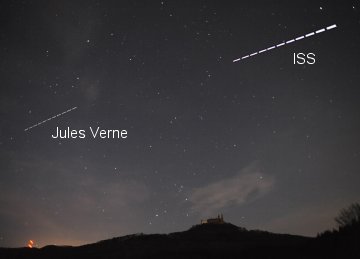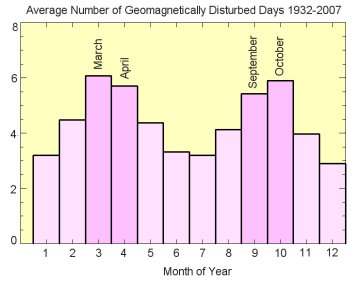| Where's Saturn? Is that a UFO--or the ISS? What's the name of that star? Get the answers from mySKY--a fun new astronomy helper from Meade. | |  | WORM MOON: There's a full moon tonight and according to folklore it is called the Worm Moon. The Worm Moon heralds warm spring days, thawing ground, robins and earthworms. Coincidentally, this year's Worm Moon is also the Paschal Moon, the first full moon of northern spring that sets the date of Easter. For reasons of dizzying complexity, involving ancient councils and ecclesiastical calendars, the Paschal Moon's arrival on March 21st has triggered an unusually early Easter: Sunday, March 23rd. The Kansas City Star has the full story. SIGHTINGS: "Now that the European Space Agency's Jules Verne cargo carrier is parked 2000 km in front of the International Space Station, observers have a good opportunity to see both spacecraft in the evening sky," says amateur astronomer Till Credner. On March 19th he photographed the pair streaking over Hohenzollern Castle in southern Germany: 
Click to play a 2.5 MB movie
"The Jules Verne appears about four and a half minutes before the ISS and they follow the same track across the sky," he says. "Jules Verne vanishes in the east just as the ISS appears in the west." These double-flybys will continue for at least another week. Jules Verne won't dock with the ISS (merging the two points of light) until after space shuttle Endeavour leaves the station on March 25th. Get your flyby alerts from Spaceweather PHONE. NEW--SIMPLE FLYBYS: Spaceweather.com has a new tool for US and Canadian readers: Simple Satellite Flybys. Just enter your zip code and it tells you about satellites due to fly over your area in the nights ahead. There are hundreds of spacecraft in Earth orbit; we cut through the confusion by narrowing the list to a half-dozen or so of the most interesting. At the moment we're monitoring the Jules Verne robotic cargo carrier, the International Space Station, space shuttle Endeavour and the Hubble Space Telescope. Please try it and, remember, it's a new tool with room for improvement. Feedback is welcomed. AURORA SEASON: When it comes to auroras, not all months of the year are equal. According to 75 years of historical records analyzed by NASA solar physicist David Hathaway, March, April, September and October are best: 
Geomagnetic storms that spark auroras seem to prefer the months around equinoxes. Why auroras should appear most often in spring and fall has long puzzled space physicists. Recently, however, NASA's fleet of THEMIS spacecraft have uncovered new clues to the mystery: full story. March 2008 Aurora Gallery
[aurora alerts] [night-sky cameras] | 
